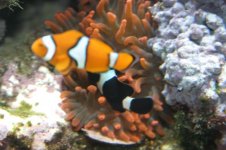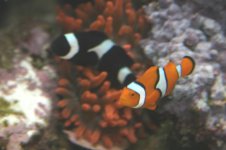Well one of our black ocellaris babies is pair bonding with one of our true percula babies. I got in two rose bubble tip anemones 11-days ago and put them into a 300-gallon revolving tank that houses a true percula and a black ocellaris among other things. Both of the clowns were hatched and reared here at Fishey Business. Neither clown had ever been kept with an anemone. It took 11-days before they were going into the first of the rose bubble tips. By tomorrow I think they'll find the other rose which is nearer the top and a bit larger. It's been a good day. 

PS
I got a hunch the black ocellaris is going to be the big bad momma.
PS
I got a hunch the black ocellaris is going to be the big bad momma.








